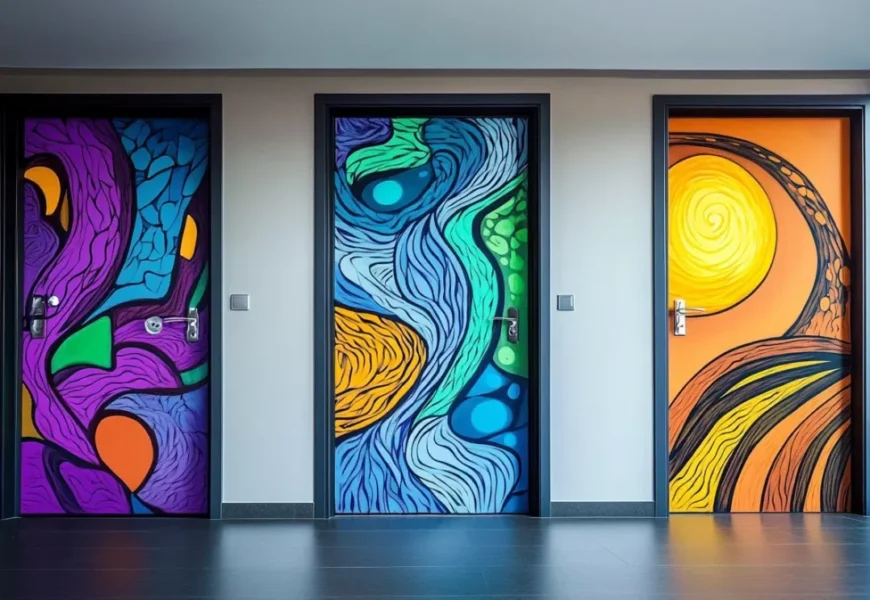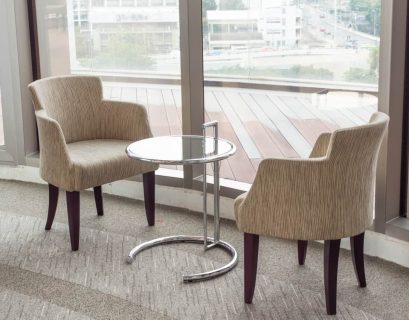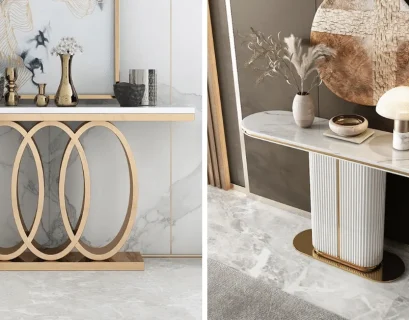Painted doors are a simple yet effective way to transform the look and feel of your home. Whether you are renovating your interior or upgrading your exterior, choosing to paint your doors can add a touch of personality, sophistication, or boldness to your space. In this article, we’ll explore the advantages of painted doors, the types of doors that can be painted, popular colors and finishes, and key tips for achieving a professional-looking result.
1. The Benefits of Painted Doors
Choosing painted doors offers several advantages, from aesthetic appeal to increased property value. Here are some of the primary benefits of opting for painted doors in your home:
A. Aesthetic Appeal
Painted doors can significantly enhance the overall look of your home. Whether you prefer a classic, neutral palette or bold, statement-making colors, painted doors offer an easy way to personalize your living space. Interior and exterior doors alike can benefit from a fresh coat of paint, creating a cohesive design that reflects your taste and style.
B. Versatility in Design
One of the best aspects of painted doors is their versatility. With a wide array of color choices, finishes, and styles available, painted doors can easily adapt to any interior design theme—be it modern, traditional, or rustic. From clean white doors to bold navy or forest green shades, your painted doors can complement the other elements of your home decor.
C. Budget-Friendly Upgrade
Painting your doors is an affordable way to give your home a fresh, updated look without having to replace the doors entirely. Instead of spending on expensive door replacements, a simple coat of paint can breathe new life into old or worn-out doors. This makes painted doors a cost-effective option for homeowners looking to renovate on a budget.
D. Durability and Protection
In addition to aesthetic benefits, painting doors can also provide a layer of protection. High-quality paints can shield doors from moisture, dust, and daily wear and tear. Exterior doors, in particular, benefit from protective paint finishes that prevent fading due to sun exposure and guard against harsh weather conditions.
E. Increased Home Value
For those considering selling their home, upgrading with painted doors can add value to the property. A well-maintained and freshly painted door gives the impression of a cared-for home, increasing curb appeal and potentially attracting buyers.
2. Types of Doors Suitable for Painting
Not all doors are created equal when it comes to painting. Depending on the material and condition of your doors, some may take paint better than others. Here’s a look at the most common types of doors that are suitable for painting:
A. Wooden Doors
Wooden doors are among the most popular and ideal surfaces for painting. Whether solid or hollow-core, wood can be easily primed and painted, allowing for a smooth and durable finish. Solid wood doors, in particular, provide a premium look when painted, enhancing both the door’s durability and aesthetic.
B. Fiberglass Doors
Fiberglass doors are often used for exteriors due to their strength and resistance to harsh weather. These doors can also be painted, offering the flexibility to match or contrast with your home’s exterior color scheme. Special primers may be required to ensure the paint adheres properly to the fiberglass surface.
C. Metal Doors
Metal doors, typically used for garages, basements, or commercial spaces, can also benefit from a fresh coat of paint. Using the right type of paint, such as oil-based or enamel paint, will help ensure a smooth, lasting finish on metal surfaces.
D. MDF and Composite Doors
Medium-density fiberboard (MDF) and composite doors are common in modern homes. They have a smooth surface that’s easy to paint, though proper priming is crucial to prevent moisture absorption and ensure longevity. MDF doors often mimic the look of solid wood at a more affordable price point, making them a great option for interior painted doors.
E. Glass-Panel Doors
For glass-panel doors, painting is usually reserved for the frame surrounding the glass. This allows you to add color and texture to the door while maintaining the transparent beauty of the glass. Frames made from wood, fiberglass, or metal can be painted to match or contrast with the interior or exterior color scheme.
3. Popular Colors for Painted Doors
Choosing the right color for your painted doors is essential in setting the tone for your space. While the best color will depend on your personal taste and the overall design of your home, there are a few popular color trends worth considering:
A. Classic Neutrals
Neutrals like white, beige, and soft gray remain timeless choices for painted doors. These shades create a clean and understated look that complements most interior styles, from modern to traditional. Neutrals are also great for smaller spaces, as they make rooms feel more open and airy.
B. Bold and Vibrant
For those looking to make a statement, bold colors such as deep blue, emerald green, or fiery red can instantly elevate the style of any room. These hues work especially well on interior doors, adding a pop of color to otherwise neutral spaces. When used on exterior doors, vibrant colors can make a strong first impression and enhance your home’s curb appeal.
C. Dark Elegance
Dark hues like black, charcoal, or navy are increasingly popular for both interior and exterior doors. These colors create a sophisticated, high-end look and are perfect for adding contrast to light walls. Dark painted doors also lend a touch of drama and formality to more traditional spaces.
D. Pastel Hues
Soft pastel shades like blush pink, mint green, and baby blue are ideal for creating a calming, inviting atmosphere. These colors are particularly suited for bedrooms, nurseries, or bathrooms, where a gentle and soothing aesthetic is desired.
E. Earthy Tones
For a more organic, natural feel, earthy tones like sage green, terracotta, and warm taupe are excellent options. These colors create a cozy, grounded ambiance and pair well with wooden accents or rustic decor elements.
4. Finishes for Painted Doors
The finish of the paint is just as important as the color when it comes to painted doors. Different finishes offer varying levels of durability, sheen, and ease of maintenance. Here are the most common types of finishes for painted doors:
A. Matte Finish
A matte finish is non-reflective and provides a soft, velvety appearance. While it’s great for creating a subtle, sophisticated look, matte finishes are more prone to showing dirt and fingerprints, making them better suited for interior doors in low-traffic areas.
B. Satin Finish
Satin finishes are a popular choice for both interior and exterior doors. They offer a slight sheen that reflects light without being overly shiny, making them easy to clean and maintain. Satin finishes work well for doors that experience moderate traffic, such as bedroom or closet doors.
C. Semi-Gloss Finish
For high-traffic areas or exterior doors, a semi-gloss finish is a practical option. It has a noticeable shine that’s easy to wipe clean, making it ideal for doors that are frequently touched, such as entry doors or bathroom doors. Semi-gloss finishes are also durable enough to withstand moisture and weather exposure.
D. High-Gloss Finish
High-gloss finishes offer the most reflective surface and are perfect for creating a bold, dramatic look. This finish is extremely durable and easy to clean, making it ideal for doors in high-use areas. However, high-gloss paints can highlight imperfections in the door’s surface, so proper preparation is crucial before painting.
5. Tips for Painting Doors
To achieve a professional-looking result with painted doors, it’s important to follow the right steps and techniques. Here are some key tips for painting doors:
A. Proper Surface Preparation
Before painting, it’s essential to thoroughly clean and sand the door to ensure the paint adheres well. If the door has an existing finish, you may need to use a primer to create a smooth base for the new paint.
B. Use High-Quality Paint
Investing in high-quality paint will pay off in the long run by providing a more durable and attractive finish. Be sure to choose a paint designed for your specific door material, whether it’s wood, metal, or fiberglass.
C. Apply Thin, Even Coats
When painting doors, apply thin coats of paint and allow each coat to dry fully before adding the next. This helps prevent drips, streaks, and uneven coverage.
D. Use the Right Tools
For a smooth, professional finish, use the right tools such as high-quality brushes or rollers. Foam rollers work well for achieving a sleek finish without brush marks, especially on flat surfaces like doors.
6. Conclusion
Painted doors offer an affordable and impactful way to elevate your home’s design, whether you’re refreshing your interior or updating your exterior. From selecting the perfect color to choosing the right finish, painted doors allow you to express your personal style while enhancing your home’s aesthetic and functionality. With proper preparation and attention to detail, you can achieve stunning, long-lasting results that will make your doors a focal point of your home.




















